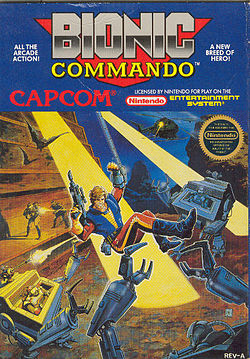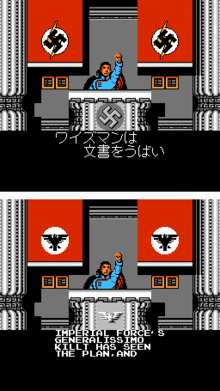- Bionic Commando (Nintendo Entertainment System)
-
Bionic Commando 
North American box artDeveloper(s) Capcom Publisher(s) Capcom Designer(s) Hatchan Composer(s) Junko Tamiya Platform(s) Nintendo Entertainment System Release date(s) Genre(s) Platforming Mode(s) Single-player Bionic Commando, known as Hitler no Fukkatsu: Top Secret (ヒットラーの復活 トップシークレット Hittorā no Fukkatsu: Toppu Shīkuretto, lit. "The Resurrection of Hitler: Top Secret") in Japan, is an action-adventure video game released by Capcom for the Nintendo Entertainment System in 1988. It is loosely based on the 1987 arcade game Bionic Commando. In the game, the player has to explore each stage and obtain the necessary equipment to progress. The protagonist is Ladd Spencer, a commando equipped with a bionic arm featuring a grappling gun, allowing the protagonist to pull himself forward or swing from the ceiling. As such, the series is one of few instances of a platform game in which the player cannot jump. To cross gaps or climb ledges, the hero must use his bionic arm.
Contents
Plot
Set sometime in the 1980s, Bionic Commando centers around two warring states: the Federation and the Empire. One day, the Imperial Forces discovers classified documents involving the development of a new weapon known as the "Albatros project" [sic], which was started by an organization known as the "Badds", but was never completed. Killt, the Generalissimo of the Imperial Forces, decides to complete the project himself. When the Federation learns of the Empire's plot, they send in their national hero, Super Joe (the main character from the Capcom game Commando) to infiltrate the Empire, but he ends up being captured. To rescue Super Joe, the Federation sends in a second operative named Ladd Spencer[2][3] of the FF (Double Force) Battalion, a team of commandos specially trained to use wired guns[3], to rescue him.[4][5]
Gameplay
Stage-selection map
Unlike other action games, instead of moving in a straight path through the levels, the player can, between levels, move around on a map-like screen. The player can move his helicopter one space at a time between the areas, represented by numbers.
Once above a numbered area, the player can either choose to descend or move to another area. The player has to complete the current level to move on, although he can go back to the map by pressing either Start, A, and B, or Select, A, and B (depending on the version). After descending in the selected area, the player will be prompted to select their desired equipment for the mission. Certain equipments are designed to work at certain areas. For example, communicator α works only in Areas 1, 4, and 5, and so on.
There are a total of 19 areas in the game. Area 1 to 12 are combat areas in which the player must visit to complete their mission, while Area 13 to 19 are neutral areas where fighting is forbidden. If the player fire their weapon at these areas, they will be attacked by a peacekeeping force. The neutral zones are a place where the player can get vital information and items to help fulfill Ladd's mission.
There are also green enemy trucks on the map selection screen that will try to intercept the player's helicopter. If the player's helicopter flies into one while traveling between areas, he will be forced to battle with enemy troops. These enemy encounters are fought from an overhead perspective similar to Commando. Destroying certain enemies at these stages, namely shielded soldiers, armed jeeps, or wired soldiers, will yield an eagle mark which will grant the player an additional continue.
Bionic arm
Ladd sports a gun with one hand and an extendable bionic gripper device on the other. His bionic arm can be extended and rotated in 45-degree increments, from horizontally left to directly upwards to horizontally right. Once attached to something, Ladd can pull himself to wherever the arm has latched, typically leaving him swinging back and forth under the point of connection. From this position, he can swing off or hoist himself up to the point of connection. This is offset by the fact that, unlike conventional platformers, Ladd is unable to jump.
The bionic arm can also deflect some types of bullets and grab certain enemies and items.
Other features
A well-known feature in this game is the possibility of communication with allied forces in order to get useful information on the current stage the player is in, or some hints. Also, the player can tap into the enemy forces' communication lines for the same results, though the enemy will sometimes detect the infiltrating line and send a squadron to attack the player.
Enemies can sometimes be defeated for "bullets", which, if the player gets enough of them, will add extra units of health. This is important because the player only starts with one life point. A maximum of nine life points can be gained, after collecting a total of 300 bullets.
Development
Localization
For the release of the international version of the game, several changes were made. All references to Nazism in text and imagery were removed for the English localization. The Empire in the Japanese version was actually a neo-Nazi nation and the Imperial Army's insignia was a Nazi Swastika with a thunderbolt behind it. In the English version, the Nazis were referred as the "Badds" (though the back-story in the American version's manual referred to them as the "Nazz"[4]), the Imperial Army's Swastika insignia was changed into a new one resembling an eagle, and the leader of the villains, originally called Weizmann in the Japanese version[3], was renamed Killt.
One of the most prominent differences involves the ultimate antagonist of the game, who is meant to be a revived Adolf Hitler in the Japanese version (hence the title). For the English version, the character was renamed "Master-D", but his likeness to Hitler was unchanged. There is a notably gory ending sequence in which Hitler's face explodes, which was kept intact in the English version.[6] Additionally, the word "damn" was left in an end-game dialog sequence of the North American release, which was almost certainly an oversight. All officially-approved Nintendo games released during this time were heavily censored for even the most benign instances of profanity, blood and gore, sexual situations, religious symbolism and ideas, and many other sources of potential controversy.
In addition to the graphical changes, the difficulty of the game was rebalanced and some of the areas were made less difficult.[7]
Music
The music for the game was composed by Junko Tamiya, who was credited under the pseudonym "Gondamin".[8] It is very highly praised for its militaristic compositional element. Two songs from the Arcade versions are used in some areas.
Reception
- 1up: A+
- Gamespot:8.6/10
Nintendo Power ranked it as the 17th best Nintendo Entertainment System video game, describing it as one of the console's most original action games due to the ability to swing.[9]
Remakes and re-releases
A portable adaptation of Bionic Commando was released for the Game Boy in 1992. The Game Boy version is based on the NES game, featuring the same gameplay and stages, as well as a similar plot, but changes the present day setting of the NES version into a futuristic one. A second remake, titled Bionic Commando Rearmed, was developed by GRIN and released in 2008 as a downloadable title for the PlayStation 3, Xbox 360, and PC. A sequel to this version, which follows an original story, was developed by Fatshark and released in February 2011.
The original NES version of Bionic Commando is one of three NES games featured in the Game Boy Advance compilation Capcom Classics Mini-Mix, the other two games being Strider and Mighty Final Fight.
Novelization
A book was written in the Worlds of Power series of novels based on the NES version. The main character is identified as Jack Markson, who loses an arm when ninjas attack his hotel room and kidnap Super Joe. The Federation replaces his missing limb with a bionic arm that has a grappling hook and a number of other gadgets that are not featured in the game, like a flame thrower and a device that forces prisoners to tell the truth. Like most books in the series, violence was toned down to non-lethality in most cases (he usually shoots enemy soldiers with tranquilizers), although certain events, like the deaths of Hal and Killt, are kept. Much of the game's middle is skimmed over in order to fit it all into the book.
References
- ^ "List of release dates from Nintendo.com". http://www.nintendo.com/consumer/gameslist/manuals/completeoldgameslist.pdf.
- ^ Capcom. Bionic Commando. Nintendo Entertainment System. Level/area: Ending. "This is Ladd, our mission accomplished."
- ^ a b c Capcom. Hitler no Fukkatsu (in Japanese). Family Computer. Level/area: Instruction Manual, page 4.
- ^ a b Capcom. Bionic Commando. Nintendo Entertainment System. Level/area: Instruction manual, page 4.
- ^ "Features - Bionic Commando". Nintendo Power (Vol. 2): p. 6–17. September/October 1988.
- ^ Sandvik, Per Arne (2002-11-15) The Horror! Encyclopedia Obscura. Retrieved on 2008-07-09
- ^ Elite Coder. "Bionic Commando Famicom Version". http://www.elitecoder.com/bionic/famiver.html.
- ^ (2009) Album notes for Bionic Commando "The Soundtrack". Sumthing Else Music Works.
- ^ (Magazine) Nintendo Power - The 20th Anniversary Issue!. Nintendo Power. 231. San Francisco, California: Future US. August 2008. p. 71.
External links
Bionic Commando video games Bionic Commando (arcade) · Bionic Commando (NES) · Bionic Commando (Game Boy) · Elite Forces · Rearmed · Bionic Commando (2009) · Rearmed 2Franchises by Capcom 19XX • Ace Attorney • Bionic Commando • Breath of Fire • Darkstalkers • Dead Rising • Devil May Cry • Dino Crisis • Final Fight • Ghosts 'n Goblins • Lost Planet • Mega Man • Monster Hunter • Onimusha • Resident Evil • Sengoku Basara • Star Gladiator • Street Fighter • Strider • Versus • Viewtiful JoeCategories:- 1988 video games
- Capcom games
- Fictional cyborgs
- Nazi Germany in fiction
- Nintendo Entertainment System games
- Nintendo Entertainment System-only games
- Platform games
- Side-scrolling video games
- Video games set in the 1980s
Wikimedia Foundation. 2010.


